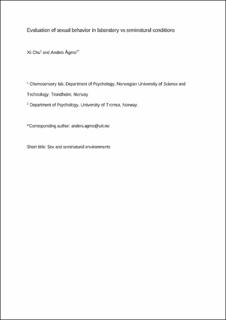| dc.description.abstract | Sexual behavior is, by necessity, sexually dimorphic. Males transfer sperm to females, whereas females receive sperm from males. Discussions of sex differences in copulatory behavior are consequently trivial. However, the behaviors associated with copulation, for example mate choice or postcopulatory reactions, may well be similar in males and females. Such differences, even subtle, are far easier to observe in seminatural environments than in the standard laboratory cage. We will present examples of the use of seminatural environments in insects and rodents. Even though most studies of insect sexual behavior are performed in relatively simple laboratory procedures, there are also some studies performed in natural or seminatural conditions. We briefly describe the most common procedures used and mention the main results. It is noteworthy that insect studies focus on sexual approach behaviors, particularly the role of visual and olfactory stimuli in mate location. The actual copulatory behavior, i.e., how gametes are transferred from one individual to another, seems to be of less interest. The sexual behavior of rats has traditionally been studied in heterosexual pairs, despite the fact that they often copulate in groups. Nevertheless, data obtained in the simplified environment have advanced knowledge of the endocrine and neurobiological control of sex behavior in a quite spectacular way. The understanding of the dynamics of the sexual interaction and the possible function of the many peculiarities of rat sexual behavior has not advanced to a similar degree. Studies in seminatural environments may provide valuable data concerning sociosexual interactions and how such interactions are modified by contextual events. Furthermore, observations made in an environment, which incorporates the basic features of rats’ natural habitat, offer some external validity. This is of importance when we want to generalize our results to contexts outside the laboratory, and it becomes of paramount important when we want to make inferences about behavior in other species, for example the human. We offer here a detailed description of an environment designed for studies of group-living rats, with notes on the observation procedure and the analysis of the large quantity of data generated in the environment. | en_US |

